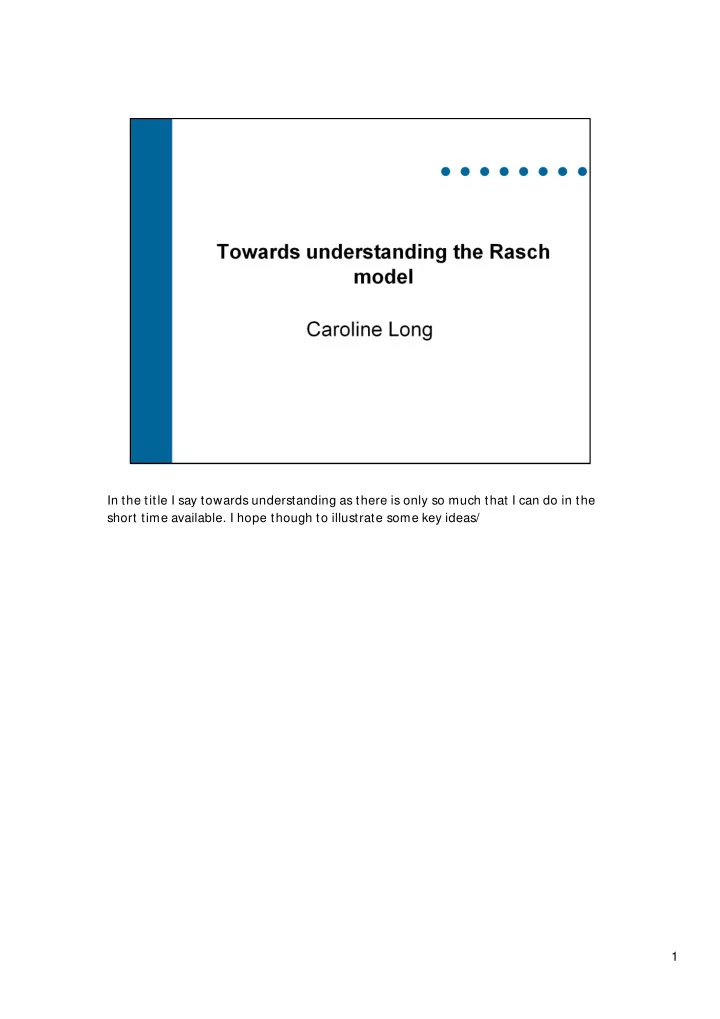

In the title I say towards understanding as there is only so much that I can do in the short time available. I hope though to illustrate some key ideas/ 1
The problem confronting the Danish government … After much deliberation about the problem he concluded that “ the error-count … .” 2
3
4
5
What has the Rasch model to do with assessment and measurement? 6
Now measurement is not always straightforward as the Science teachers will know. Even the calculation of length took decades before we had a standard measure. The first step is to understand what we are measuring. The example given here is that of density. I am not a science teacher but I imagine the history of establishing a density measure was quite fraught until they found the two variables which could provide a measure (or estimation, more and more accurate depending on the instrument) of density. 7
8
Now what is this young girl up to? Do you think she is going to make this jump? What are her chances? 9
10
Back to education. One of the key plays in the educational measurement story was Guttman who proposed an ordering of persons and items as follows 11
Learners do not function as expected. For example an easy item … a difficult item … an able learner … Look for example at person U. 12
I am going to take you through a simple process that in some senses explains the ideas behind the Rasch model, though I might miss out some steps. 13
14
15
16
In the Rasch model application we work in reverse. We know the probability for the item and we know the probability for the person. What needs to be done is for these probabilities to be distributed across the items for a particular person, and across the persons for a particular person. By successive iterations, the person by item probability is found for every combination. In ideal circumstances, where the data fit the model these estimates can be found. But where there are serious flaws or anomalies this process is thwarted. The researcher has to go back to the data and the instrument to check for the problem. 17
Now what is this young girl up to? Do you think she is going to make this jump? 18
19
20
21
22
And here we have the mathematical expression which governs the Rasch model for success in dichotomous items . The person ability B and the Item difficulty D. We find the log of the odds as difference between the ability and the difficulty. Note that Beta minus Delta is the log of p/ 1-p, where p is the number correct and 1-p the number incorrect 23
The first expression provides for the probability of getting a correct response. The second the probability of an incorrect response. Their ratio is the odds of success versus failure. 24
This figure provides a graphical illustration of the functioning of an item . The red line shows the increasing probability of attaining a correct answer, as person ability increases . Likewise the blue line shows the decreasing probability of answering incorrectly, as person ability increases . The horizontal axis shows the person location along a scale from -3 to +3, with -3 being lower proficiency on this test and +3 higher proficiency. The vertical axis indicates the probability of a correct response, from zero to one. Note the point where the blue and the red lines cross. Its x-value is at about 0.4. This value is by definition the estimated difficulty level of this item. 25
Item mean is set at zero for every context. Items located at higher difficulty level at the top, low difficulty level at the bottom; Likewise higher proficiency level at the top, lower proficiency level at the bottom Imposed levels which align with logits, (log-odds units) The relationship of learner proficiency to item difficulty is such that when a learner is located at the same level as a particular item they have a 50% probability of getting the item correct. If the item is located at a greater level of difficulty than the person they have a lesser probability of a correct answer. Let us look at a particular item. Now I have party packs for you. I would like you to take your Wright map (after Ben Wright a student of Georg Rasch. Place this on the table in front of you. Then find in your pack the graph that looks like the one displayed on the screen. Now rotate this graph 90 degrees in an anti-clockwise position and place it on the wright map so that the logits map onto each other. 0 with zero, -1 with -1 etc. Now look to see where Item 10 is on the Wright map. What does this mean? For the purpose of this presentation I have selected items at graded levels of proficiency Selected particular interviews. 26
27
28
Recommend
More recommend